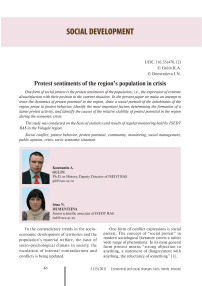Energy-intensity factors in the Komi Republic's economy
Автор: Chaika Larisa Viktorovna
Журнал: Economic and Social Changes: Facts, Trends, Forecast @volnc-esc-en
Рубрика: Branch-wise and regional economy
Статья в выпуске: 3 (15) т.4, 2011 года.
Бесплатный доступ
In the article the analysis of energy efficiency of the regional economy are presented for a purpose to indentified quality characteristics its dynamics and factors of relatively low level. Application of comparative statistics and regression analysis methods made it possible to estimate the impact of the most important factors. Results shown that high level of energy intensity was due to “northern” economy and industry specialization. A main factor of energy-intensity dynamics was scale effect of economy production. Structural and technological trends of energy-saving were not found. Selection of energy efficiency index as indicators of quality regional development requires monitoring and analysis of energy-economic dependency, improving information basis.
Energy efficiency of regional economy, factors of energy-intensity, komi republic
Короткий адрес: https://sciup.org/147223268
IDR: 147223268 | УДК: 620.9.004.18(470.13)
Текст научной статьи Energy-intensity factors in the Komi Republic's economy
The power efficiency’s increase is one of the main strategic reference points of the development of Russia’s economy [1]. It can be achieved as a result of the structural changes of the economy and technological enhancement. The “structural” power-saving will be carried out due to the outstripping development of the little power-hungry kinds of activity. Production enhancement will allow providing about 40% of the economy in the total amount of the power resources consumed nowadays. As a whole the powersaving development should raise the national economy’s efficiency and competitiveness, and ecological and power safety [2-5].
The scientific support of the managerial process by power-saving consists in the methodology’s development, toolset development and information base for the economic energy effectiveness’ analysis and forecast, its regional and functional components. The analytics should be aimed at revealing the factors of power consumption, determining the power-saving effects and potential, at choosing correct priorities and managing impacts. Methodical issues and the results of the analysis and the forecast of the energy effectiveness’ parameters as important macroeconomic indicators are paid much attention in the scientific researches of the Russian economy and power [6-10].
The regional detailed elaboration of the mentioned problem is necessary from the point of view of system approach, decomposition and decentralization in planning and management. In this article the results of the analysis of the Komi Republic economy’s energy effectiveness are represented. The accounting data published by the Federal Service of State Statistics of the Russian Federation served as the initial information.
The purpose of the carried out analysis consisted in estimating the factors influencing the level and the dynamics of power consumption in the regional economy. As it is known, economy’s power consumption (as a matter of fact, it is a phenomenon opposite to energy effectiveness) depends on the branch structure of production, on the enhancement degree of power-consuming technologies, on the climatic features.
These factors are mentioned as the most significant at the comparative analysis and international comparisons [6-10]. The energy effectiveness’ changes occur under the influence of structural and technological factors, production growth. The structural factor as it was already mentioned is connected with transformations of aggregate output for the benefit of increase in a share of more or less power-consuming industries.
Technological changes of the energy effectiveness occur owing to enhancement, introducing new power-saving technologies, and also as a result of worsening or improving production conditions connected, for example, with the quality of raw materials in processing branches or with geological conditions in extractive branches. The scale effect is caused by the fact that some part of energy needs, as a rule, is both a conditional and a constant one, and the other part changes proportionally to the quantity of the released products, therefore with the growth of production output the power consumption reduces.
To determine the importance of the mentioned factors for the regional economy means to reveal its qualitative features and “internal reserves”, directions and opportunities of transformation by means of energy effectiveness’ growth.
The power consumption parameter is determined by the ratio of the spent power resources’ (SPR) volume to the made products’ amount. With the reference to the total economy’s product, power consumption is the quantity of the initial power resources of all kinds measured in the identical power equivalent (either conditional or oil fuel), falling for a unit of the made total added cost (TAC).
Estimating power consumption in economy in absolute calculation it is important to define what fuel and energy resources (FER) and what volumes of them are necessary to be taken into account. Divergences in estimating the volumes of FER can arise for example, in connection with the account of non-fuel power resources (nuclear and renewable energy sources), the volumes of natural fuel used as raw material, and also FER export (see [7, p. 43]), making a rather essential affect on economic productivity of home economy. Various probable estimations of power consumption in the Russian Federation economy and in the economy of the Komi Republic are represented in table1 .
If power consumption is estimated by FER expenses for power needs (including transport), in 2005 this parameter of Russia’s economy made 47 t c.f./mill. rub. TAC in the current basis prices, or 0.59 t c.f./one thousand doll. at recalculation of the gross national product to purchasing capacity (12.74 rub./doll. in 2005); or in the oil equivalent 0.41 t o.e./thousand doll. While operating with such estimations of power consumption, it is necessary to have in view that for total production both in Russia and the Komi Republic much more power resources are involved (see table 1).
Table 1. FER use volumes and rated power consumption of the total product of the Russian Federation and the Komi Republic
|
Generalizing parameters |
Volumes of use, mill. t c.f. |
Power consumption, t c.f./mill. rub. TAC in the current prices |
||||||
|
The Russian Federation |
Komi Republic |
2005 |
2008 |
|||||
|
2005 |
2008 |
2005 |
2008 |
Russian Federation |
Komi Republic |
Russian Federation |
Komi Republic |
|
|
Resources FER in total |
1,717 |
1,773 |
30.3 |
33.4 |
93 |
177 |
50 |
113 |
|
Including: natural fuel for home and export consumption |
1,605 |
1,659 |
30.3 |
33.4 |
||||
|
non-fuel energy resources: |
112 |
114 |
0 |
0 |
||||
|
Total consumption of the initial energy resources |
1,060 |
1,132 |
14.2 |
15.0 |
57 |
83 |
32 |
51 |
|
including natural fuel* |
948 |
1,018 |
||||||
|
Consumption FER for power needs |
864 |
909 |
10.1 |
10.4 |
47 |
59 |
26 |
35 |
|
including fuel for transformation to other kinds of energy |
411 |
425 |
6.0 |
6.4 |
22 |
35 |
12 |
22 |
|
Total FER consumption without taking into account the charge for non-fuel production and needs |
960 |
1,024 |
10.4 |
10.7 |
52 |
61 |
29 |
36 |
|
Home FER consumption (according to the data [1]) |
949 |
991 |
||||||
|
including non-fuel energy resources |
106 |
103 |
||||||
* Energy, developed by nuclear, hydraulic, geothermal and wind-driven power stations.
Source: according to the data of the stat. coll.: Russia’s Statistical Year-Book, 2006, 2009; Statistical Year-Book of the Komi Republic, 2009; Use of fuel and energy resources in the Komi Republic, 2009.
The part of them in the system of the national accounts makes expenses – the charge for power (power consumption) and raw needs included in intermediate and final consumption, the other part forms a profitable part – export. But this component of the cost and the power balances can be estimated not in the context of the power consumption analysis, but in the parameters of the economy’s qualitative structure, its export and raw orientation, in the degree of single-profile or diversity.
The regressive analysis of the energy efficient parameters’ dynamics in the economy of the Komi Republic since 2000 (fig. 1) has shown the statistically significant linear dependence of the fuel-consumption volumes from the rates of growth of the gross regional product (GRP).
More than a half of the total amount of fuel consumption (6 from 10 million t in 2009) is determined by regress as a conditional and constant component; the rest is determined as the variable component dependent on the production growth of GRP. The attribute of linearity specifies the primary impact of the production scale factor. Under the condition of these tendencies’ continuation in the nearest prospect it is possible to expect that the subsequent growth of GRP, for example, for 10-15% for three years will be accompanied by power consumption reduction for 4-7% (to the level of the year of 2009).
The comparison of the macroeconomic parameters’ dynamics in Russia and in the Komi Republic (tab. 2) shows that the main difference consists in a less intensive real growth of the gross product in the republic in comparison with the growth rate of the national economy: 132% and 166%. Thus, the considerable lag in the rates of power consumption decrease is observed.
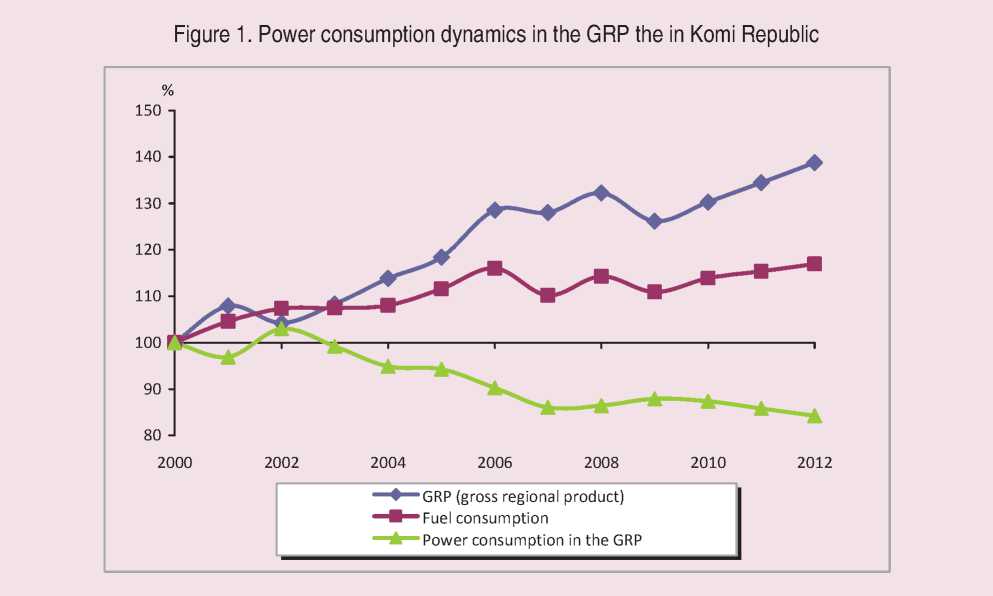
Table 2. Energy economic parameters in the year of 2008 to the year of 2000, %
|
Parameter |
The Russian Federation |
Komi Republic |
|
Population |
97 |
92 |
|
Real growth of the gross national product and gross regional product |
166 |
132 |
|
Nominal growth of the gross national product and gross regional product |
570 |
497 |
|
Deflator of the total added cost |
344 |
376 |
|
Volume of the fuel consumption |
116 |
114 |
|
Power generation |
118 |
120 |
|
Heat production |
94 |
103 |
|
Power consumption in the gross national product and gross regional product |
70 |
86 |
|
Electro capacity of the gross regional product |
72 |
91 |
|
Thermal capacity of the gross regional product |
57 |
78 |
It is possible to judge about the lag degree in the power consumption dynamics connected with the rates of economic growth by the results of the regression analysis of interrelation between the dynamics of the initial power resources’ consumption in the economy of the Russian Federation and the rates of growth of gross national product. The statistically significant linear dependence for conditional calculating power consumption in the gross national product of the Russian economy was ensued at the growth rates of the gross regional product in the Komi Republic.
The graphic representation of the results (fig. 2) shows that the most part of the Komi Republic’s lag in the rates of the power consumption decrease in comparison with the all-Russian dynamics is caused by the low intensity of economic growth. But it is also obvious that the considerable number of divergences is connected with qualitative attributes (structural and technological features of the Komi Republic economy).
Power consumption in the Komi Republic economy is higher than the average Russian level; at the period from 2005 to 2008 it made 29%.
Figure 2. Comparative dynamics of power consumption in the economy of the Russian Federation and in the economy of the Komi Republic
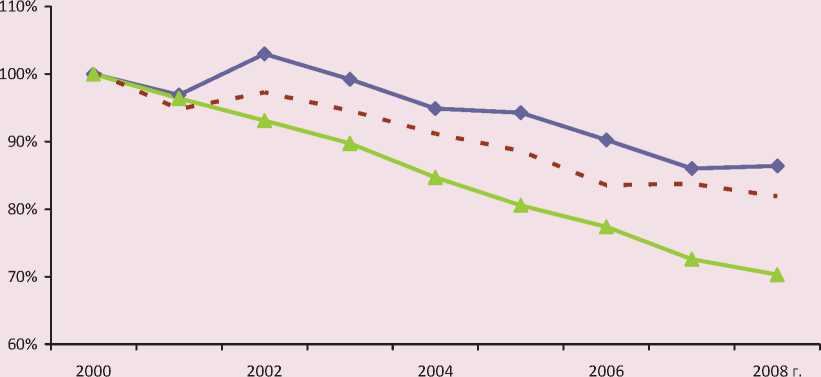
Power consumption in the gross regional product of the Komi Republic, fact
Power consumption in the gross national product of the Russian Federation, fact
Power consumption in the gross national product of the Russian Federation, conditional calculation at the growth rates of the gross regional product of the Komi Republic
The increased power consumption is caused by “the northern character” of the economy, by the climatic and geographical features and it is the consequence of the branch production specialization in the Republic (prevalence of the power-intensive industries and pipeline transport). What factor makes the most impact? To answer this question the energy economic proportions of the regional and the Russian economy in the light of two aggregated segments are determined: power consumption sphere of production where industry and transport are referred, and non-power consumption sphere including the other kinds of economic activities (production of non-industrial goods and nontransport services) and communal-general needs of the population (fig. 3) .
Power consumption of the mentioned economic segments was estimated basing of the “reduced” volume of FER which meant the charge of the initial power resources caused by the final use of fuel and the transformed energy.
That is, at calculating power consumption the volumes of the initial power resources spent for electric and thermal energy generation were proportionally distributed among the consumers according to the volumes of the energy used by them in view of losses. In comparison with the economy of the Russian Federation, in the Komi Republic the power consumption segment dominates over the considered parameters (see fig. 3).
Represented energy economic proportions allow to estimate the influence of the structural factor of the economy from the ratio:
0,66
0,41
• 0,58 +
0,34
0,59
• 0,42 = 1,18.
Figure 3. Production structure of the gross product and energy supplies’ use in average for the period from 2005 till 2008
Gross added cost
Reduced volume of FER
Thermal energy
Electric power
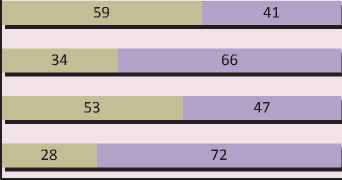
The Russian Federation economy
20% 40% 60% 80% 100%
0%
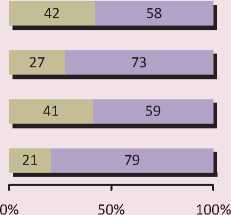
Economy of the Komi Republic
-
■ Non-power-hungry production and population
-
■ Power-hungry sphere of production
Figure 4. Power consumption of production in the gross added cost in average for the period from 2005 till 2008, t c.f./ mill. rub. in the prices of 2005
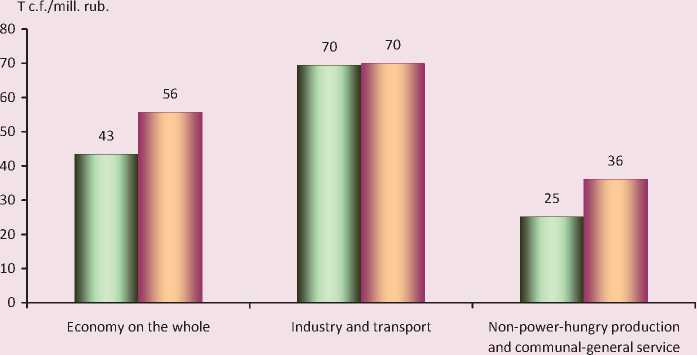
□ The Russian Federation CThe Komi Republic
Hence, about 18% of the power consumption gain in the economy of the Komi Republic (of 29%, mentioned above) in comparison with the average Russian level can be explained by a more “industrial” structure of the regional production.
The comparative analysis of the production energy effectiveness of the considered economic segments (fig. 4) on the average showed the following things for the mentioned period. For the power consumption sphere of production including industry and transport, the republic’s parameter corresponds with the average Russian one (about 70 t c.f./ mill. rub. in gross added cost in the prices of the year of 2005). The parameters of the non-power-consuming sphere are much lower, almost to in 3 times (the Russian Federations) and in 2 times (the Komi Republic), and the republic’s parameter exceeds the average Russian parameter in 1.4 times. The latter circumstance can be connected with the so-called “northern character” of the Komi Republic economy, in particular, with high energy needs in the social and communal-general spheres in view of the climatic and settled features.
Thus, on the average for the period from 2005 till 2008 the influence of factors of the production structure and “the northern character” on the production’s power consumption excess in the gross regional product in the republic made accordingly 0.6 and 0.4, or in absolute calculation they make additional 8 and 5 t c.f./mill. rub. in gross additional cost in the prices of the year of 2005.
Let’s note that for each year of the considered period the results prove to be true with insignificant variations: in 2005 and 2006 the structural factor prevailed, and in 2007 and 2008 the importance of geographical factor began to grow. For the parameters of power consumption in 2008 in the current prices (see tab. 1) the excess of 9 t c.f./mill. rub. is caused by our estimation: 5 – by the factor of the structural specialization and 4 – by “the northern character”.
In details the power consumption’s estimation in the economy’s segments in 2008 is represented in table 3 , from which it follows that the energy efficiency of the considered units, except for industry, is situated below corresponding average Russian parameters. Especially more than the triple excess of the power consumption by the transport system can be noted. As the basic part of the fuel charge in this segment of Komi Republic’s economy falls at the main gas-supplying system, the excessive power consumption of this kind of activity is determining. As for the more energy efficient industrial production in the Komi Republic in comparison with the average Russian level it is necessary to point out the branch specialization feature as the determining factor: minerals’ extraction forms the most part of incomes in the Komi Republic industrial production – 68% of the total gross added cost in the Komi Republic industries, in comparison with 31% in the Russian production; and the power consumption of this kind of activity is in many respects lower (see tab. 3) due to the conjunctural features
Table 3. Components of power consumption in the economy of Russia and the Komi Republic, 2008
|
Power consumption, t c.f./mill. rub. in gross added cost |
Relative excess of Komi Republic parameter, times |
||
|
Russian Federation |
Komi Republic |
||
|
Economy on the whole |
25.7 |
34.9 |
1.4 |
|
Power-hungry sphere of economy, in total and including: |
43.3 |
44.7 |
1.0 |
|
Industrial production |
45.8 |
29.6 |
0.6 |
|
- minerals’ extraction |
26.1 |
19.1 |
0.7 |
|
- processing production |
57.0 |
53.3 |
0.9 |
|
- production and distribution of energy, gas and water* |
40.8 |
44.8 |
1.1 |
|
Transport** |
32.3 |
118.7 |
3.7 |
|
Non-power-hungry sphere of economy and population, in total and including: |
14.4 |
22.1 |
1.5 |
|
Agriculture and forestry |
11.3 |
28.5 |
2.5 |
|
Construction |
4.4 |
9.1 |
2.1 |
|
Other activities in services*** |
4.4 |
7.7 |
1.8 |
|
Communal-general needs of the population, t c.f./per head for a year |
(1.42) |
(1.75) |
1.2 |
* Power consumption was estimated under the power resources’ charge on own needs.
** In view of the activity “communication”, which a priori is necessarily to be referred to non-power-hungry activities but its parameters are incorporated with transport by official statistics. However, the fault of this parameters is slight.
*** Activities in services’ sphere except for transport.
of the oil-and-gas market, providing high profitableness of extraction. The parameters of power consumption by industry and resources-providing infrastructures in the Komi Republic do not strongly differ from the average Russian level, within the limits ±10%. The lower energy efficiency of the considered units of nonpower-hungry spheres in the Komi Republic economy draws attention. And as it was already mentioned, the main reasons for this are the factors of “the northern character”, leading to the relative decrease of economic activities’ profitableness. So, concerning the Komi Republic agriculture, it is logical to assume that the high power consumption is caused by a lower efficiency of agricultural production in the north (connected with crop capacity and specialization), and also by the necessity of the power resources’ additional charge owing to the climatic and transport conditions. The similar situation – a smaller share of incomes in production cost and additional needs for energy – is characteristic for construction and services of the northern economy. But there still remains the question: what part of the power consumption gain is objectively caused, and what part can be reduced while carrying out power-saving activity? For the proved response a more detailed energy economic analysis on the basis of disaggregated data on economic results and consumption of various power resources in different kinds of activity, typical processes and products is necessary.
It is possible to judge indirectly about the additional power load on the economy because of the climatic features from the comparison of the data on communal-general consumption of the population. The specific parameter of the per head “reduced” FER charge for providing communal-general needs of population in the Komi Republic is higher than the average Russian parameter for 25 % (see tab. 3). Hence, the comparative power consumption in the sphere of non-material services exceeding the mentioned level represents the lag in its economic productivity and the presence of power-saving reserves.
Summarizing the analysis of energy efficiency in the Komi Republic economy, we should underline its basic features.
- A rather high power consumption is caused by the features of the branch production structure and by “the northern character”, and the importance of these factors is approximately identical.
- The slow growth of energy efficiency is caused by low rates and quality of economic development. The power-saving effect is mainly connected with the increase in production scales. No steady power-saving tendencies in structural economic transformations and in realization of technological enhancement were revealed.
-
- Among the basic branch components of the economy the most power-hungry kind of activity is pipeline gas transporting and processing production.
-
- The significant (more than in 1.5 times) excess of the average Russian level of power consumption of the aggregated kinds of economic activities characterizes transport, agriculture, construction and services in the Komi Republic.
In addition, let’s note some expected features of the perspective dynamics of energy efficiency in the Komi Republic. Estimation of technological power-saving potential in the republic carried out earlier [11] showed that it makes about one third of the total amount of the used power resources. Its development, despite the slow rates – for 10 years, would provide doubling nowadays rates of the power consumption reduction and, under the certain conditions, the additional annual 1% gain in gross regional product. In distribution of the general potential to the activity fields in the republic the basic directions are similar to those in Russia: power supply systems’ enhancement, power-consuming industry and transport, housing and communal services [11, p. 74].
But the general state of affairs with realizing technological power-saving in the republic does not differ from the all-Russian state. Hence, the purposes and mechanisms of technological enhancement of economy are entirely projected from the federal level to the republican one, and the success of its realization depends on favorable macroeconomic conditions and effective measures of stimulation. As for the structural shifts of the economy, the prognosis researches showed [11, 12], that the mainstreams of economic activities’ specialization in the republic – oil-and-gas, mining, wood complexes and transit transport – will keep the basic positions in the future. Realization of the large-scale investment projects, among which there are powerconsuming industries, is planned: construction of bauxite-aluminous complex, gas pipeline “Yamal – Center” and an oil pipeline “Western Siberia – Indiga”, new capacities in the cellulose and paper industry. While realizing such projects, the macroeconomic dynamics will be accompanied not by the acceleration, but the delay of the rates of energy efficiency growth. Therefore, in the republican economy there are no preconditions for achieving the all-Russian reference point of the perspective development – power consumption decrease for 40% by 2020 (decree of the President of the Russian Federation, June, 4, 2008, № 889).
The new accent of the importance of the energy efficiency analysis in the regional economy is connected with a choice of the parameter of power consumption in gross regional product as an indicator of the executive authorities’ activity (Decree of the President of the Russian Federation, May, 13, 2010, № 579). It will make actual both monitoring and the analysis of the energy economic interrelations: it is necessary not only to estimate statistical parameters, but also to determine significant factors of their level and dynamics, to differentiate the results of the “natural” economic processes and the effects initiated by the administration’s activity.
It was shown that the economy of the Komi Republic is a more power-consuming economy than the Russian one, and it is probable, that such position will be kept further. But this feature has the objective bases, such as specialization and “the northerness”. Alongside with it, the considerable reserve of the energy efficiency’s growth – out-of-date production enhancement – is not paid attention. There also can be various reasons of low rates of the energy efficiency’s growth: power-saving absence, development of power-consuming industries or decrease of the regional incomes connected with redistribution processes. For the proved choice of the significant factors it is necessary to carry out monitoring of the energy economic dependences, to improve information support and to expand analytical researches on influencing the power basis of economy on the efficiency and the quality of the regional development.
Список литературы Energy-intensity factors in the Komi Republic's economy
- Russia's Power Strategy for the period till 2030/decree of the Government of the Russian Federation November, 13, 2009 № 1715-r//Legislative Assembly of the Russian Federation. -30.11.2009. -№ 48. -Item 5836.
- Bushuyev, V.V. Energy efficiency and Russia's economy/V.V. Bushuyev, A.A. Troitsky//Tariff regulation and expert examination. -2004. -№ 3. -Pp. 98-103.
- Bashmakov, I. Russia's resource of energy efficiency: scales, expenses and benefits /I. Bashmakov//Economy's issues. -2009. -№ 2. -Pp. 71-89. -Access mode: http://www.cenef.ru/file/FINAL_EE_report_rus.pdf)
- About energy efficiency and energy economy//Power Policy. -2009. -№ 4 -Pp. 26-36.
- Bushuyev, V.V. Scientific bases and monitoring of energy efficiency/V.V. Bushuyev//Power Policy. -2003. -№ 4. -Pp. 3-8.
- Bushuyev, V.V. Efficiency as the indicator of the social development/V.V. Bushuyev//Power Policy. -2008. -№ 5 -Pp. 40-47.
- Volkonsky, V.A. About power consumption in the national economy and the factors determining it/V.A. Volkonsky, A.I. Kuzovkin//Economics and mathematical methods. -2003. -V. 39. -№ 4. -Pp.72-81.
- Volkonsky, V.A. Analysis and forecast of power consumption and energy efficiency in Russia's economy/V.A. Volkonsky, A.I. Kuzovkin// Проблемы прогнозирования. 2006. № 1. С. 53-61.
- Dynamics of power consumption and per head energy consumption in Russia with a background of global tendencies/Y.D. Kononov, Y.V. Galperova, O.V. Mazurova, V.V. Posekalin//Power of Russia in the XXI century: problems and scientific bases of the steady and safe development: the reports of the All-Russian Conference September, -17, 2000. -Irkutsk: The Siberian Branch of the Russian Academy of Science, 2001. -Pp. 40-48.
- Energy economic forecasting of the regional development/O.V. Buriy, A.A Kalinina., L.Y. Kukresh ; ed. V.N. Lazhentzev; Institute of Socio-Economic and Energy Problems of the North Komi SC of the Ural RAS department. -M.: Science, 2008. -365 p.
- Chaika, L.V. Forecast of Komi Republic's economic development/L.V. Chaika//The regional economy. -2008. -№ 4. -Pp. 71-79.

